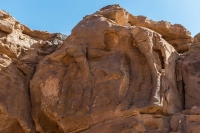
The Camel Carving Site is an archaeological site of prominent rock drawings, located on the facade of a mountain in the city of Sikaka, the administrative capital of al-Jawf Province in the north of the Kingdom of Saudi Arabia. The site was discovered by a joint Saudi-French scientific team in 2016. Inscriptions and history of the Camel Carving Site The Camel Carving Site encompasses rock carvings of camels. The inscriptions date back to more than 5,200 years BC, and the site is one of the dist...
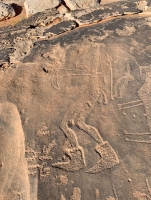
The Inscription of Hudaybat al-Mudhalaani in Tayma' is a Thamudic inscription discovered in 2009 at the site of Hudaybat al-Mudhalaani, located thirty-five km northeast of the city of Tayma' in Tabuk Province, Kingdom of Saudi Arabia. Its significance lies in being one of the longer Thamudic inscriptions known, and it is notable for containing several terms that appear for the first time in Thamudic inscriptions. Text of the inscription of Hudaybat al-Mudhalaani in Tayma' The dat...
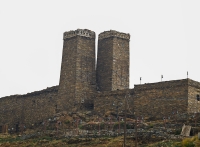
The Twin Fortresses are two archaeological fortresses located in al-Bahah Province, southwestern Kingdom of Saudi Arabia. Their construction dates back four hundred years. They were built by two brothers for military observation purposes and also served as food warehouses. History of the Twin Fortresses The two fortresses are located in the village of al-Malad, south of the city of al-Bahah, on the side of the road leading to Baljurashi Governorate. Adjacent to these towers lies a structure wh...
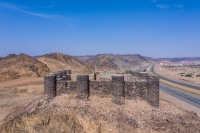
Asfan Historical Fortress is an archaeological site in al-Jumum Governorate in Makkah Province in the Kingdom of Saudi Arabia . It is considered one of the most prominent historical monuments that were constructed to protect roads, trade caravans, and pilgrims in the past. It dates back to the sixth century AH, during the Ayyubid Dynasty's reign over the region. The construction of Asfan Historical Fortress Asfan Fortress was constructed from basalt rocks that were brought from the adjacen...
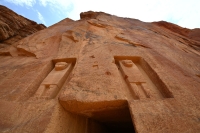
The Lion Tombs Inscription in al-Ula Governorate is a collection of inscriptions that are believed to have been written in the ninth or tenth century. They are among the inscriptions found in al-Ula Governorate and carry significant historical value. These inscriptions are part of the Islamic inscriptions along the Levant Hajj Route in the northwest of the Kingdom of Saudi Arabia. They include statements affirming the testimony of monotheism ( Shahada ), declarations of seeking forgiveness ( Is...
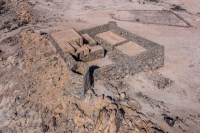
Al-Arfaa Monuments , Al-Arfaa Mountains, are among the archaeological sites in Makkah Province in the Kingdom of Saudi Arabia . They are adjacent to Souk Okaz , east of Taif , and are considered one of the most prominent rock-inscription sites in the region. They include animal drawings such as goats, deer, etc., dating back to the pre-second millennium BC, in addition to Thamudic inscriptions and Kufic scripts. Monuments discovered in Al-Arfaa Al-Arfaa Monuments' site is linked to the geo...
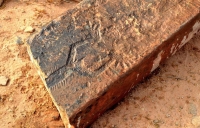
Rock Inscriptions in al-Ghadah are a set of rock inscriptions located in the southwestern part of the city of 'Unayzah in al-Qassim Province, Kingdom of Saudi Arabia. 1 They depict aspects of social life from past eras. 2 Location of al-Ghadah inscriptions The rock inscriptions are located within the boundaries of al-Ghadah Parks in 'Unayzah Governorate, approximately twenty-one km southwest of 'Unayzah City, along al-Dhalaa Road. As such, they are considered part of the tourist ...
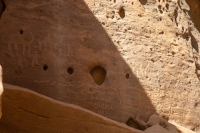
The Islamic Inscriptions in Mount Umm Daraj in al-Ula consist of four inscriptions, possibly dating back to the ninth century. They are part of a set of inscriptions found in al-Ula Governorate and hold significant historical value. These inscriptions are among the Islamic inscriptions along the Levant Hajj route located northwest of the Kingdom. 1 2 Inscription declaring holding firmly to the rope of Allah The inscription was written on a rocky facade on Mount Umm Daraj, with a shallow depth a...
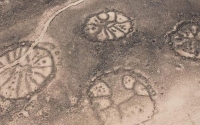
The Stone Structures on Jabal al-Dhulayat are archaeological sites located on Jabal al-Dhulayat in al-Jawf Province, north of the Kingdom of Saudi Arabia. They were discovered by Saudi and international archaeologists, as part of the results of archaeological survey projects conducted by the Heritage Commission, in cooperation with international scientific centers. The history of the stone structures on Jabal al-Dhulayat The stone structures on Jabal al-Dhulayat are among the oldest stone struc...
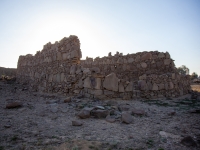
The Archaeological Findings in Tayma consist of a collection of sites and artifacts found in Tayma Governorate in Tabuk Province , north of the Kingdom of Saudi Arabia, making Tayma one of the most important historical and archaeological areas in the Kingdom. Artifacts in Tayma One of the archaeological findings in Tayma Governorate include human bones dating back to 120,000 years ago. Additionally, fossils of elephant tusks have been found, along with a large collection of fossils from vario...
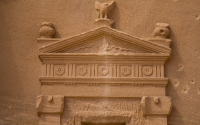
Archaeological Inscriptions in al-Ula are a collection of inscriptions that are dispersed throughout the valleys, cliffs, and caverns within al-Ula Governorate, Kingdom of Saudi Arabia. The origins of some of these inscriptions date back to the Safavid, Aramaic, Thamudic, Minaean, Greek, and Latin civilizations, while others trace back to ancient Arab kingdoms and the early Islamic era. These inscriptions serve as invaluable windows into the daily life of ancient people. Notably, al-Ula is home...
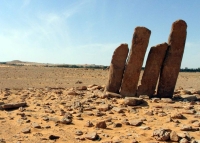
The Columns of Rajajil is an archaeological site in al-Jawf Province , Kingdom of Saudi Arabia . It is located approximately ten km southeast of the city of Sakaka , the administrative capital of the province. Archaeological findings dating back to the Chalcolithic Age, around seven thousand years ago, were found at the site. Features of the Columns of Rajajil site The site is characterized by the presence of groups of stone columns that align towards the sunrise and sunset. The columns are d...